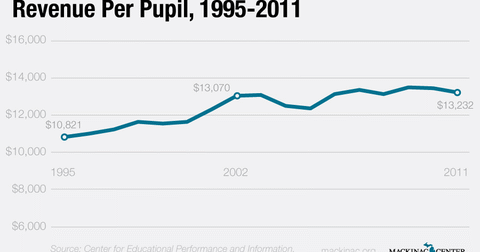Despite Claims, Michigan School Funding Higher Than a Decade Ago; Way More Than Decades Past
MSU professor ignores billions in education analysis; districts receiving over $13K per pupil
David Arsen, a self-described “school finance specialist” and professor at Michigan State University, recently published an open letter to Gov. Rick Snyder. He devoted much of this letter to criticizing legislation from last year’s session (specifically House Bill 5923) and a rough draft of proposed modifications to Michigan’s school funding laws.
But Arsen also makes the claim that “[b]etween 2002 and 2011, real per-pupil funding of Michigan’s public schools fell by $2,643 or 24.5 percent,” suggesting that there has been a “collapse” in revenues for public schools.
This is incorrect.
Michigan schools actually received more total per-pupil revenue in 2011 than they did in 2002, after adjusting for inflation (see chart nearby). Arsen arrives at his false conclusion by excluding billions of dollars taxpayers provide public schools each year.
Arsen’s data source is the Michigan Department of Education’s Bulletin 1011. Although he claims these data include revenues for intermediate school districts — they do not (I confirmed this fact with the Michigan Department of Education). This error omits about $2 billion of local and state revenue for public education, much of it dedicated for special education. Ironically, Arsen criticizes the proposed school funding reforms in his open letter for not addressing special education funding.
Further, Arsen excludes all federal revenue from his analysis. Since a lot of federal revenue is restricted for certain uses, this is somewhat more justifiable than leaving out ISD revenue. Over the last few years, however, a significant portion of federal revenue was used to bolster schools’ general operating funds, which Arsen’s data are meant to represent. From FY 2009 to FY 2011, Michigan schools received about $1.55 billion from the federal government for general operating expenditures.
Finally, Arsen ignores all taxpayer funds provided for school districts to finance buildings, technology and other capital expenditures. Since school officials routinely claim that these revenues help improve educational quality, from a taxpayer’s perspective, it doesn’t make sense why this revenue shouldn’t count.
According to data from the Center for Educational Performance and Information, taxpayers gave districts about $1.6 billion for such purposes in 2011. After ignoring these revenues, Arsen then blasts the proposed school funding reforms for not including recommendations to improve funding for school facilities.
When total revenues for Michigan schools are adjusted for inflation, Arsen’s narrative of revenue-challenged schools falls apart.[1] State, local and federal taxpayers supplied Michigan public schools (including ISDs) with 22.3 percent more revenue per pupil in 2011 than 1995. Although real per-pupil revenue has decreased slightly over the last few years, it is still higher (1.2 percent) than 2002, the year Arsen picked as a point of comparison.
None of this is meant to gloss over the fact that many school districts in Michigan have faced severe cost pressures, and coupled with a declining student population, this makes budgeting school finances tight and difficult.
But the insinuation that taxpayers are not doing their part to provide enough revenue to public schools in Michigan is not rooted in facts — at least when one includes all of them.
[1] Arsen uses a national government price index to account for inflation. This index grew faster over the last decade than the Consumer Price Index, which I use here. The CPI is more commonly used as a measure of inflation. The CPI takes into account regional difference in prices, and this makes it somewhat better suited to adjust local- and state-based spending.
Michigan Capitol Confidential is the news source produced by the Mackinac Center for Public Policy. Michigan Capitol Confidential reports with a free-market news perspective.


 As schools see record budget, prominent Democrat says that’s not enough
As schools see record budget, prominent Democrat says that’s not enough
 Michigan clawing back $2.7B from 350,000 people
Michigan clawing back $2.7B from 350,000 people
 Michigan hasn’t defunded education
Michigan hasn’t defunded education
Jobs agency ghost-writes its own public relations